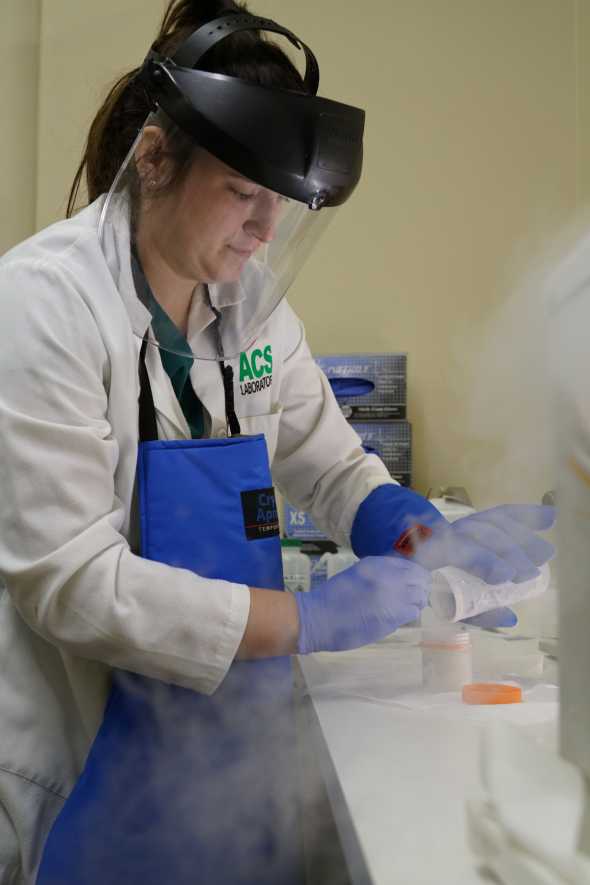Hemp Testing in Florida: What Growers Need To Know
Florida has been recognized as having one of the most stringent hemp regulatory programs in the country. Regulations can be a hassle, but they also provide protection for growers and companies that are manufacturing and/or selling products containing cannabidiol (CBD) that have been extracted from the plant.
For growers of hemp, before harvest they must have a designated third-party lab conduct a test on their plants to ensure the tetrahydrocannabinol (THC) level in the flower/bud is below 0.3%. THC is the compound in cannabis that is psychoactive and gives the feeling of being high. CBD is the compound most hemp farmers are growing the crop for and is said to have various therapeutic attributes for conditions like inflammation and stress.
ACS Laboratory, based in Tampa, is a designated lab providing testing services to Florida hemp growers. The lab is the largest facility of its kind in the Eastern U.S. and provides testing for medical marijuana in addition to other testing services. In addition to testing a significant percentage of the hemp grown in Florida, the lab also tests hemp from 48 other states.
Roger Brown, President of ACS Laboratory, says the level of hemp testing required in Florida is significant. He says one way to think about it is wherever there is a sell, there are required tests.
“The hemp that is harvested to sell hemp flower must be tested,” Brown says. “Hemp oil can be extracted and sold as an oil. The oil can be used to make different types of products. All those products must be tested. We test all sorts of different products including topical lotions, food additives, drinks, cookies, cakes, candies, bath bombs, gummy bears, and the list goes on.
“If you are producing a hemp product that you want to be able to sell in all 50 states, and if you can meet the Florida regulatory standards, you can sell in all states,” Brown says. “That’s because Florida’s rules are the tightest.”
Starting in the Field
The most important test for growers is the one conducted by third-party companies like ACS Laboratory to determine if the hemp plant, and more specifically its flower or bud, is below 0.3%. Those tests are taken in the field or greenhouse and analyzed in the lab. The results are then shared with the Florida Department of Agriculture and Consumers Services (FDACS), which administrates the state hemp program. If the hemp passes the test, FDACS notifies the grower and he or she can harvest the crop. Currently, the crop must be harvested within 15 days of notification from FDACS, which can create some logistics challenges for growers. An upcoming rule change will widen that window to 30 days.
What if the crop comes back “hot” or above the legal 0.3% THC limit?
“It used to be that the crop would have to be destroyed if the test results came back hot,” Brown says. “But now they have a remediation process that gives the grower some options. They can sell the stalks for fiber and other industrial hemp purposes, but the flower must be destroyed.”
Avoiding the hot crop has been one of the learning experiences when growing hemp in Florida. Brown says ACS Laboratory prides itself in being a resource to growers as they gain experience with the crop.
“We know that the THC level goes up with stress on the plant,” he says. “Does it have too much sunlight? Too much water or not enough? Too much fertilizer or not enough? Even soil type can influence stress levels and THC. The bottom line is with hemp, you don’t want stress. And you don’t want to leave the plants unharvested too long.”
ACS Laboratory has advised growers to experiment with hemp production on a small scale first to learn more about how it will perform on their land and soil types.
Designating Lots
In testing, a “lot” is a designation given to a field or square footage in indoor growing. Brown says there are a few considerations when determining lots on the farm. Each lot will require THC testing for FDACS clearance.
“How you define the lot is important,” he says. “You can have only one strain of hemp per lot, but you can have multiple lots of the same strain. Strategically, you don’t want to have your lots too large, because if you get a hot test result, you will have to destroy that whole lot. You can mitigate that risk by having smaller lots. For example, if you have a hot result on the east side of a field and you don’t test hot on the west side of the property, you won’t have to destroy an entire field if it is broken into multiple lots. It is going to cost you more upfront on testing, but it could save you a lot of money in the long run.”

ACS Laboratory is the largest cannabis testing lab of its kind in the Eastern U.S.
Photo courtesy of ACS Laboratory
Hemp and Heavy Metals
One of the tests that hemp products must undergo is for residues of heavy metals picked up from the soil. Tests also are conducted for chemical residues on the plant that are potentially picked up from spray drift.
Hemp is such an effective tool in removing heavy metals from the soil, scientists have planted the crop around the nuclear disaster Chernobyl site in the Ukraine. The plants have shown the ability to significantly remove soil toxins. The process is called bioremediation, essentially means using living things to heal the soil.
For growers considering hemp on lands where heavy copper has been applied, it might be worth testing in advance to determine if it could impact future hemp crops and required testing.









